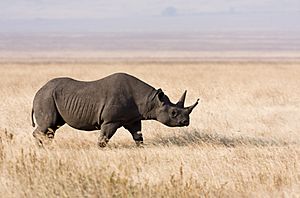South-central black rhinoceros facts for kids
Quick facts for kids South-central black rhinoceros |
|
|---|---|
 |
|
| South-central black rhinoceros at the Ngorongoro Crater in Tanzania | |
| Conservation status | |
| Scientific classification |
|
| Kingdom: | Animalia |
| Phylum: | Chordata |
| Class: | Mammalia |
| Order: | Perissodactyla |
| Family: | Rhinocerotidae |
| Genus: | Diceros |
| Species: | |
| Subspecies: |
D. b. minor
|
| Trinomial name | |
| Diceros bicornis minor (Drummond, 1876)
|
|
The south-central black rhinoceros (Diceros bicornis minor) is a special kind of black rhinoceros. It is also known as the south-central hook-lipped rhinoceros or the lesser black rhino. This animal is a subspecies, which means it's a group of animals within a species that has slightly different traits.
Even though it is the most common type of black rhinoceros, it is still in great danger. Experts have listed it as critically endangered on the IUCN Red List. This means it is very close to disappearing from the wild forever. Like other black rhinos, it has a unique, pointy upper lip. This lip helps it grab leaves and twigs from bushes. These rhinos live in savanna areas, which are grasslands with scattered trees.
Where Do South-Central Black Rhinos Live?
South-central black rhinos once lived in many parts of Africa. Their home used to stretch from western and southern Tanzania through Malawi, Zambia, Zimbabwe, and Mozambique. They also lived all the way to northern and eastern South Africa.
Scientists believe they also lived in the southern Democratic Republic of the Congo. They were found in northern Angola and eastern Botswana too. Today, most of these rhinos live in northeastern South Africa and Namibia. Smaller groups are found in Zimbabwe. A very small number live in Eswatini's Mkhaya Game Reserve.
At one time, these rhinos had disappeared from Malawi, Botswana, and Zambia. But thankfully, they have been brought back to these countries. It is not clear if any still live in Mozambique. However, at least one rhino was seen there after 2008.
Why Are South-Central Black Rhinos in Danger?
The number of south-central black rhinos has dropped a lot in the last 50 years. Their population went down by 90%. In 1980, there were about 9,090 of them. But by 1995, their numbers fell to only 1,300. This big drop was mostly because of illegal poaching.
Poaching means hunting animals illegally. Rhinos are poached for their horns, which are very valuable on the black market. After 1995, their population started to grow a bit. By 2001, there were 1,651 rhinos. By 2010, the number reached about 2,200.
In 2010, Namibia had 2,196 rhinos, with 1,684 of these in South Africa. Kenya had 938, Zimbabwe had 431, and Tanzania had 212. Smaller groups were in Zambia (58), Malawi (56), Eswatini (48), Rwanda (28), and Botswana (23). Sadly, only seven black rhinos remained in Chad and two in Mozambique.
Today, the total number of these rhinos is increasing. However, in some areas like Zimbabwe, their numbers are still going down. The biggest danger to these amazing animals is still illegal poaching. Poaching has become a bigger problem in recent years.


